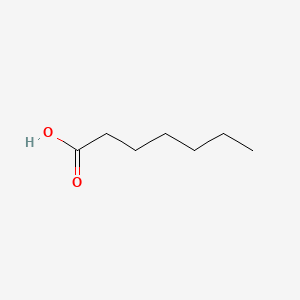| MeSH term | MeSH ID | Detail |
|---|---|---|
| Olfaction Disorders | D000857 | 17 associated lipids |
| Byssinosis | D002095 | 11 associated lipids |
| Mitochondrial Diseases | D028361 | 25 associated lipids |
HEPTANOIC ACID
HEPTANOIC ACID is a lipid of Fatty Acyls (FA) class. Heptanoic acid is associated with abnormalities such as Dehydration. The involved functions are known as Process, Anabolism, inhibitors, Oxidation and fatty acid oxidation. The related lipids are Heptanoates and undecanoic acid.
Cross Reference
Introduction
To understand associated biological information of HEPTANOIC ACID, we collected biological information of abnormalities, associated pathways, cellular/molecular locations, biological functions, related genes/proteins, lipids and common seen animal/experimental models with organized paragraphs from literatures.
What diseases are associated with HEPTANOIC ACID?
HEPTANOIC ACID is suspected in Dehydration and other diseases in descending order of the highest number of associated sentences.
Related references are mostly published in these journals:
| Disease | Cross reference | Weighted score | Related literature |
|---|
Possible diseases from mapped MeSH terms on references
We collected disease MeSH terms mapped to the references associated with HEPTANOIC ACID
PubChem Associated disorders and diseases
What pathways are associated with HEPTANOIC ACID
There are no associated biomedical information in the current reference collection.
PubChem Biomolecular Interactions and Pathways
Link to PubChem Biomolecular Interactions and PathwaysWhat cellular locations are associated with HEPTANOIC ACID?
There are no associated biomedical information in the current reference collection.
What functions are associated with HEPTANOIC ACID?
Related references are published most in these journals:
| Function | Cross reference | Weighted score | Related literatures |
|---|
What lipids are associated with HEPTANOIC ACID?
Related references are published most in these journals:
| Lipid concept | Cross reference | Weighted score | Related literatures |
|---|
What genes are associated with HEPTANOIC ACID?
There are no associated biomedical information in the current reference collection.
What common seen animal models are associated with HEPTANOIC ACID?
There are no associated biomedical information in the current reference collection.
NCBI Entrez Crosslinks
All references with HEPTANOIC ACID
Download all related citations| Authors | Title | Published | Journal | PubMed Link |
|---|---|---|---|---|
| McLachlan RI et al. | Relationship between serum gonadotropins and spermatogenic suppression in men undergoing steroidal contraceptive treatment. | 2004 | J. Clin. Endocrinol. Metab. | pmid:14715841 |
| Laska M et al. | Olfactory sensitivity for carboxylic acids in spider monkeys and pigtail macaques. | 2004 | Chem. Senses | pmid:14977806 |
| Schubert M et al. | Intramuscular testosterone undecanoate: pharmacokinetic aspects of a novel testosterone formulation during long-term treatment of men with hypogonadism. | 2004 | J. Clin. Endocrinol. Metab. | pmid:15531493 |
| Cherrier MM et al. | Relationship between testosterone supplementation and insulin-like growth factor-I levels and cognition in healthy older men. | 2004 | Psychoneuroendocrinology | pmid:14575730 |
| Ohta K et al. | Separation and conductimetric detection of C1-C7 aliphatic monocarboxylic acids and C1-C7 aliphatic monoamines on unfunctionized polymethacrylate resin columns. | 2004 | J Chromatogr A | pmid:15250420 |
| Ohta K et al. | Application of polymethacrylate resin as stationary phase in liquid chromatography with UV detection for C1-C7 aliphatic monocarboxylic acids and C1-C7 aliphatic monoamines. | 2004 | J Chromatogr A | pmid:15250419 |
| Amory JK et al. | Exogenous testosterone or testosterone with finasteride increases bone mineral density in older men with low serum testosterone. | 2004 | J. Clin. Endocrinol. Metab. | pmid:14764753 |
| Corrales JJ et al. | Partial androgen deficiency in aging type 2 diabetic men and its relationship to glycemic control. | 2004 | Metab. Clin. Exp. | pmid:15131775 |
| De Lisi R et al. | Heat capacity of transfer of (Ethylene oxide)13-(propylene oxide)30-(ethylene oxide)13 from water to the aqueous anionic surfactant solutions at 298 K. A quantitative treatment. | 2004 | Langmuir | pmid:15518478 |
| Olpin SE | Implications of impaired ketogenesis in fatty acid oxidation disorders. | 2004 | Prostaglandins Leukot. Essent. Fatty Acids | pmid:14769488 |
